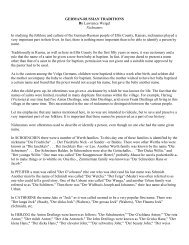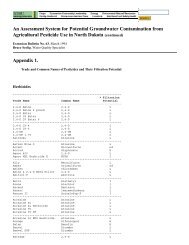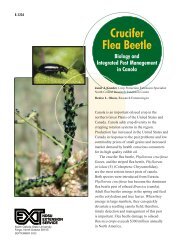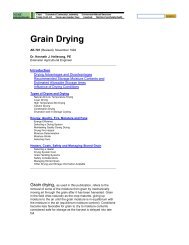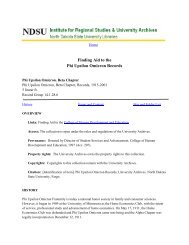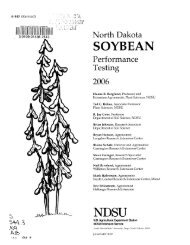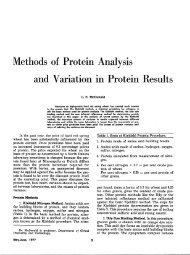You also want an ePaper? Increase the reach of your titles
YUMPU automatically turns print PDFs into web optimized ePapers that Google loves.
<strong>Pigweed</strong> <strong>is</strong> <strong><strong>to</strong>xic</strong> <strong>to</strong> <strong>Pigs</strong> K. Wohlgemuth, G.J. Schamber, A.R. M<strong>is</strong>ek, J.D. CrenshawRedroot pigweed (Amaranthus retroflexus L.) may belethal <strong>to</strong> pigs .<strong>Pigweed</strong> <strong>is</strong> a major agricultural weed throughout NorthDakota; fence rows, farm yards and empty lives<strong>to</strong>ck lotstend <strong>to</strong> have luxurious pigweed growth, especially duringwarm months. A d<strong>is</strong>tinct health proble m known as"perirenal edema" may affect hogs (2 ,3) , and sometimescattle (6), fo lloWing ingestion of sufficient quantities of theweed. The term "perirenal edema" describes the appearanceof the kidneys and t<strong>is</strong>sues surrounding them inpigs victims of pigweed po<strong>is</strong>oning.CAUSE OF KIDNEY DAMAGEPerirenal edema <strong>is</strong> attributed <strong>to</strong> ingestion of excessiveamounts of redroot pigweed. In hogs, the problem <strong>is</strong> commonlyobserved during summer months. Most affe cted pigshave weighed 30 <strong>to</strong> 120 pounds and the clinical h<strong>is</strong><strong>to</strong>rieshave usually involved sudden access by hogs <strong>to</strong> pasture orgreen plants following a period of confinement. Clinicalsigns have appeared four <strong>to</strong> eight days after access <strong>to</strong> theweed.fluid (Fig. 1), thus the term "perirenal edema." Microscopicexamination of kidney specimens reveals extensive kidneydamage characterized by d<strong>is</strong>tention, degeneration andnecros<strong>is</strong> of kidney tubules (2) . The clinical signs and grossrenal changes result from kidney damage cause by pigweed<strong>to</strong>xin(s) .So far, no effective treatment for th<strong>is</strong> condition <strong>is</strong> known;prevention <strong>is</strong> easier. Confined pigs should not be allowed <strong>to</strong>eat the weed . Interestingly, hogs ra<strong>is</strong>ed on pasture with freeaccess <strong>to</strong> red root pigweed seldom if ever become victims ofpigweed <strong><strong>to</strong>xic</strong>os<strong>is</strong>. Th<strong>is</strong> suggests that pasture-ra<strong>is</strong>ed hogseither avoid the weed or develop reS<strong>is</strong>tance <strong>to</strong> its <strong><strong>to</strong>xic</strong> prlnciple(s).PIGWEED TOXICITY TO PIGS CONFIRMED ATNDSURain and sunshine provided favorable conditions forabundant growth of redroot pigweed in most North Dakotacounties during the summer of 1986. Previous experimentsRedroot pigweed may accumulate nitrate, but clinicallyperirenal edema bears no resemblance at all <strong>to</strong> nitratepo<strong>is</strong>oning. Somehow hogs readily ingest pigweed, evenwhen their normal diet <strong>is</strong> plentiful. The actual <strong><strong>to</strong>xic</strong> principle(s)in the weed, although not yet identified, appears <strong>to</strong>speCificall y damage the tubules of the kidney. Depending onhow much weed a pig ingests, the kidney damage maybecome extensive and severe and cause death from heartfailure (2).CLINICAL SIGNS AND LESIONSClinical signs are of sudden onset and appear four <strong>to</strong> eightdays after animals started <strong>to</strong> eat pigweed . Initially I affectedpigs are weak and tremble ; later th ey appear incoordinated,knuckle their pastern joints and eventually become paralyzedin their hind limbs; their attempts <strong>to</strong> walk fail as they dragtheir rear legs. Their temperature remains normal. Deathusually occurs within two days follOWing onset of clinicalsigns (3) .Postmorte m examination reveals pale-brown kidneys surroundedby abundant jelly- like light-colored material andWohlgemuth <strong>is</strong> Extension Veterinarian; Schamber <strong>is</strong> associateprofessor alld M<strong>is</strong>ek <strong>is</strong> research techniCian , Veterinary Science; andCrenshaw <strong>is</strong> ass<strong>is</strong>tant p rofessor, A nimal & Range Science.Figure 1. Kidneys from piglets victim of pigweed <strong>to</strong>ldcos<strong>is</strong>. Kidneys are pale and surrounded by abundant edema (arrows). 21
at NDSU had indicated that pigweed was not <strong><strong>to</strong>xic</strong> <strong>to</strong>labora<strong>to</strong>ry rats (1) or rabbits (4). A simple test was conducted<strong>to</strong> determine if pigweed growing in North Dakotawas <strong><strong>to</strong>xic</strong> <strong>to</strong> pigs .Two young pigs, weighing 8 and 12 pounds respectively,were deprived of feed for 24 hours. They were bled <strong>to</strong>assess their kidney function, penned <strong>to</strong>gether and offered.twice daily, freshly picked, whole redroot pigweed plants astheir only fee d . The plants, collected fro m fields near the·NDSU campus, were lush, about 18 <strong>to</strong> 24 inches taU and intheir early <strong>to</strong> mid bloom. During the first day the pigs justnibbled at the plants , but from the second through the fourthday they devoured them without hesitation; only some rootswere left. Both piglets appeared and acted nonnal until themorning of the fifth day when they appeared l<strong>is</strong>tless, wererecumbent and unable <strong>to</strong> stand up. They had lost 1.5 and1.3 pounds respectively. They were killed and labora<strong>to</strong>ryexaminations performed .The results of these examinations revealed markededema surrounding the kidneys of both pigs (Fig. 2); therewas severe, acute , d<strong>is</strong>seminated dilation and necros<strong>is</strong> ofkidney tubules . Analys<strong>is</strong> of blood sera taken right beforeeuthanasia revealed marked elevation of blood ureanitrogen (BUN) and creatinine levels. These results are cons<strong>is</strong>tentwith renal failure in pigs associated with ingestion ofredroot pigweed. Furthermore, the results of th<strong>is</strong> testdemonstrated beyond doubt that ingestion of large amountsof North Dakota varieties of redroot pigweed can be lethal <strong>to</strong>pigs .REFERENCES1. Harrold , R. , Animal Science Dept., NDS U. Personal commun ication. Figure 2. Abdominal cavity from pig victim of pigweed <strong>to</strong>xIcos<strong>is</strong>. Kidneys are pale, swollen, and surrounded by abundantedema (arrows).2. Osweiler, G.D., et 01. 1969. "Production of Perirenal Edemain Swine with Amoronthus retrof/exus." Am. J . Vet. Res .,30(4) :557-566.3. Osweiler, G.D., et 01. 1985. "CUnical Veterinary TOXicology,"3rd Ed ., Kendall-Hunt Publ<strong>is</strong>hing Co.: 476-481.4. Schamber, G.J . and A.R. M<strong>is</strong>ek. 1985. "Amoronthusre trofl~u~, (redroot pigweed): Inability <strong>to</strong> cause renal <strong><strong>to</strong>xic</strong>os<strong>is</strong>In rabbits . Am. J. Vet. Res ., 46(1):266-2675. Stuart , B.P., et 01. 1975. "Perirenal Edema and ToxicNephros<strong>is</strong> in Cattl ,AssocIated with Ingestion of <strong>Pigweed</strong> ."JAVMA, 167(1 0) :949-950.Continued from page 8The leading re ason affecting land sellers <strong>to</strong> sell was theneed <strong>to</strong> reduce debt. Second and th ird reasons wereeconomic conditions or low commodity prices and poorreturn on investment. Lender pressure was l<strong>is</strong>ted as fourth ,followed by forced sale , and retirement or health or estatesettlements . Among those l<strong>is</strong>ting a second reason , most fre quently given were estate settlements , followed byeconomic conditions and the need <strong>to</strong> reduce debts.Major fac<strong>to</strong>rs infl uenCing the 1986 farmla nd market includedlow commodity prices, poor conditions of theeconomy, availability of credit, and low return on investment.The leading second reasons Ilste d were availability ofcredit and low commodity prices.Respondent were asked <strong>to</strong> venture an estimate of howland values a year from now will comp are <strong>to</strong> current values.The majority, with 65 percent, indicated that November1987 land values will be down by 5 percent or more . Nearlya th ird said that fall 1987 land values will be about the sameas now, and less than 4 percent had the optim<strong>is</strong>m <strong>to</strong> say thatla nd val ues will be higher at year end.22



